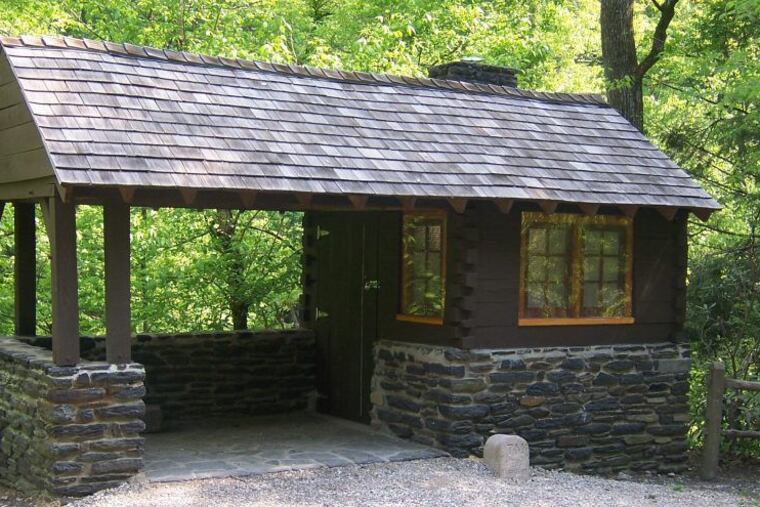Wissahickon Valley Park has ‘urgent’ need for more bathrooms
After years of increasing use at Wissahickon Valley Park, the need for more bathroom facilities has become glaring. But how many, where, and what kind?

Visits to Wissahickon Valley Park have been increasing for a decade and the need for more bathroom facilities has become glaring — but how many toilets, what kind, and where?
The answers are not easy for a city park that sprawls across 1,800 acres, is crisscrossed by 50 miles of trails, and now accommodates millions of visitors a year.
“The restroom situation, especially in the summer, is urgent,” said Ruffian Tittmann, executive director of Friends of the Wissahickon, a nonprofit volunteer organization. “When you spend a lot of time working in the park, you spend a lot of time talking about toilets.”
Friends of the Wissahickon has restarted a master plan for restroom facilities that went dormant during the pandemic. The nonprofit works with the city’s Parks and Recreation Department, which owns and manages the land. The Pennsylvania Department of Conservation and Natural Resources is supporting the plan with a $75,000 grant, plus a matching grant from an undisclosed private donor.
The park was designated this summer as a “hot spot” by the Leave No Trace Center for Outdoor Ethics, a national nonprofit environmental organization, that said the area is suffering from severe human-related impacts because it gets so many visitors. Park use has doubled over the last decade and reached peak levels during the initial months of the pandemic.
Though the number of visitors have dipped this year compared to last year’s historic high, more visitors are now using the park off-season than in the past. And, increasingly, the southern part of the park, which has the least bathroom access, is seeing heavier use.
» READ MORE: Wissahickon Valley Park designated a ‘hot spot’ because of overuse
Tittmann hosted a public meeting Tuesday to gather input for the project’s consultant NV5. The park has 11 total restrooms. Only six toilets and one urinal are open year round, with nine seasonal portable toilets.
Rosa Mannion, a landscape architect with NV5, said the park should have 25 restrooms based on a formula used by the Trust for Public Land.
A survey conducted by the consultants show the park is rated highly by nearly three-quarters of visitors, and more than half live locally. A majority rated new permanent bathrooms with hand-washing sinks as a priority.
About a quarter of park users need a restroom each time they visit, and almost a third saying they “frequently” need one. About 12% say they use “nature’s restroom” while visiting, leading to public health concerns, although there is no indication that is polluting the Wissahickon Creek.
But many factors go into choosing where, and when, to place toilets, Mannion said. Currently, the park has a mix of full flush toilets, composting toilets and portable toilets. All have drawbacks.
For example, flush toilets with sinks need access to utilities and must be cleaned daily. Compostable toilets can become overwhelmed by use, negating their ability to compost. Portable toilets need to be serviced almost daily by their third-party owners. And officials need to consider accessibility issues — not a priority for the Work Projects Administration, the government agency that built some of the original structures during the Great Depression in the 1930s.
Most respondents to an online survey conducted among those at the meeting felt the Valley Green Inn on Forbidden Drive has the greatest need for additional facilities, followed by the Bells Mill West upper parking lot. But visits to Blue Stone Bridge at Forbidden Drive have also increased significantly, indicating a demand for more restrooms there.
Tittmann said toilets simply can’t be placed “every two feet” with “500 bathrooms scattered around the park.”
The group also has to winnow down the type of construction, involving a range of materials and engineering such as stainless steel, vandalism-proof, prefabricated, fully or partially plumbed, or custom wood facilities. Prices can range from $25,000 for a waterless composting toilet to $111,000 for an all-metal structure. The cost of a portable can run $1,000 a week.
Here is the current mix of toilet facilities:
Kitchens Lane and Forbidden Drive: One composting toilet; one seasonal portable toilet.
Wissahickon Environmental Center: Two composting toilets.
Valley Green Inn: Two women’s toilets and one men’s flush toilet plus urinal.
Blue Bell pavilion: Two women’s and one men’s flush toilet plus urinal; two seasonal portable toilets.
Pachella pavilion: One women’s and one men’s flush toilet plus urinal.
Bells Mill Road: Two seasonal portable units.
Northwestern Ave. parking area: Two seasonal portable units.
Allens Lane: One seasonal portable toilet.
David P. Montgomery Field: One seasonal portable toilet.
Tittmann said a second public meeting will be held by the end of the year, with decisions on new facilities made by December or January, with placement predicted by 2023.
“We really have to be careful about what we’re proposing,” she said